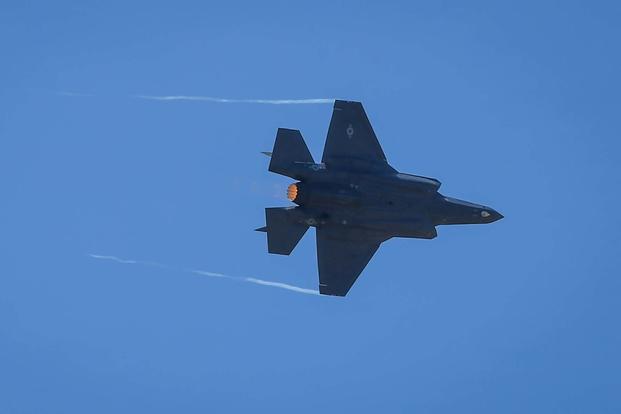SALON DU BOURGET, France -- There are now 220 F-35 Joint Strike Fighters in service around the world, but there has never been a public aerial demonstration of the aircraft's maneuver capabilities. At least, not until now.
An F-35A from Hill Air Force Base, Utah, made history Monday here at the Paris Air Show with a series of maneuvers that Air Force and industry personnel say demonstrate its ability to square off in agility against any fourth-generation aircraft.
The F-35 has been featured prominently at the show, with a static display requiring 24-hour armed security in addition to a daily six-minute aerial demonstration.
Officials confirmed the two F-35As would participate in the show after it was reported this spring that the aircraft had not been invited. A final decision to send the Air Force aircraft to Paris was made in May, just a month before the show.
Related content:
- See Military.com's Full Coverage of the 2017 Paris Air Show
- Lockheed Debuts C-130J SOF for International SpecOps
- Could This Next-Gen Cockpit System End Hypoxia-Like Incidents?
But the demonstration, designed by test pilots with manufacturer Lockheed Martin, has been in planning for more than a year, every move designed to highlight the advanced capabilities of the aircraft, the pilot flying the aircraft said Tuesday.
The approved demonstration includes, among other features: a square loop, a slow-speed pass at less than 115 miles per hour followed by a steep vertical climb, and a 360-degree minimum radius turn.
"Why do we bring a fifth-generation airplane whose dominance and sensor fusion have nothing to do with an air show? It's because seeing is believing and, for 10 years, no one quite understood. And we have struggled so often to explain the quantum leap of what fifth-gen dominance is all about," Lockheed test pilot Billie Flynn told reporters ahead of his second demonstration flight.
"And frankly, you've got to see it face-to-face, you've got to listen to the noise before you come to believe it," he said. "So we take simple, yet orchestrated, maneuvers to unleash the beast that is the F-35 to help make everyone understand, because it's visceral to see what this airplane does."
The aerial demonstration comes two years after a leaked test pilot brief revealed internal doubts about the F-35's ability to dogfight, or participate in close combat with another aircraft.
War is Boring reported in 2015 that a test involving the F-35A and the F-16 Fighting Falcon showed the 5th-generation aircraft "at an energy disadvantage": unable to climb or turn at the speeds necessary to face off against another aircraft or evade enemy fire.
But Lockheed's chief F-35 test pilot, Alan Norman, crowed that this week's demonstrations erase all doubts about speed and maneuver. "I have thousands and thousands of hours in the F-16. I just can't do some of this stuff in an F-16," he said.
One such maneuver, Norman said, is a high-altitude pedal turn featured in the demonstration that highlights the pilot's ability to point the nose of the aircraft precisely and maintain total control, even while battling gravity in descent.
"The only aircraft I've ever done that in is an F-22," he said. "I think what we're trying to really get across that you haven't been able to see, that we've known all along, is the fantastic handling qualities and maneuvering of this airplane."
Moves such as the pedal turn and the slow pass highlight the F-35's ability to stay on an enemy's tail or lose a hostile aircraft with rapid deceleration in a "Top Gun"-style maneuver. The square loop shows how the plane can turn on a dime at high and low speeds as it continues the fight.
The F-35 is still flying with a limited envelope: Since the two aircraft that went to the show are equipped with 3I software, instead of the 3F version, they are restricted to pulling 7 Gs or fewer. The total envelope, with the final software version, will go up to 9 Gs, Norman said.
While fourth-generation aircraft with impressive and precise maneuvering capability abound around the world, Norman said the F-35 is unlike some competitors in that it completed the demo in its combat configuration.
"Most likely that [Russian-made] Su-35 you see performing at an air show has been cleaned off; it is in an air show profile," Norman said. "So probably doesn't have any pylons, doesn't have any weapons, it is in a configuration that will not fight in combat. The F-35 in its configuration is how it will fight in combat. It carries weapons internally; it would fly just the way it was flying in this demo if it was out there fighting an SU-35."
Unlike the F-22, the Air Force's other fifth-generation fighter, however, the F-35 wasn't designed for close combat. It specializes in close-air support and ordnance missions and has been hailed for its ability to destroy fourth-generation fighters before they even become aware of its presence, thanks to its stealth profile.
Flynn said the aircraft's true strengths can't be seen in an air show.
"If you see it up there, if that airplane impresses you, just imagine the real special part of an F-35 is what you'll never ever see out there," he said. "It's like fighting Mr. Invisible."
-- Editor's Note: The location of Hill Air Force Base has been corrected in the second paragraph.
-- Hope Hodge Seck can be reached at hope.seck@military.com. Follow her on Twitter at @HopeSeck.
Related Video:
The Lightning II performs its first public aerial exhibition at the 2017 Paris Air Show. Don’t pass out during the vertical climb!































